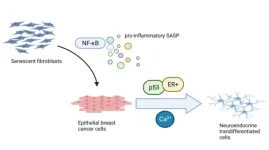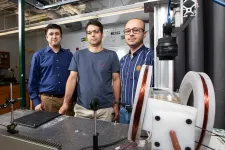(Press-News.org) The spread of drug-resistant microbes has become a global health concern that threatens our ability to treat infections. The widespread use of antimicrobials in livestock, such as swine farms, exacerbates this problem. Therefore, we need surveillance systems to monitor these microbes to support the public health authorities. To this end, researchers have tracked the antimicrobial resistance of Escherichia coli isolated from swine.
Antimicrobials are essential for preventing and treating infections in humans and animals. According to the US Food and Drug Administration, 70% of all antibiotic sales in the US are used for livestock production. However, microbes change over time to combat these chemicals, eventually becoming resistant. As a result, infections become harder to treat. Concerningly, these resistant organisms can spread from farm animals to humans, creating a bigger health crisis.
The researchers focused on E. coli since these bacteria are ubiquitous in the intestinal tract of humans and pigs, and they are good indicators to test whether meat and meat products have been contaminated. E. coli can also acquire and transfer resistance genes to other bacteria in the intestinal tract, making them ideal for monitoring programs of livestock and humans.
“It is important to monitor the emergence of antimicrobial-resistant bacteria in the swine industry because in 2022 the US was the third largest producer and consumer of swine meat and products, after the European Union and China,” said Hamid Reza Sodagari, a postdoctoral research associate in the Varga lab. “Although it is a big problem, to the best of our knowledge this paper is the first surveillance study in the US that looks at antimicrobial resistance in E. coli from swine at slaughter.”
The study used publicly available surveillance data of cecal samples, which were collected from the intestine after slaughter. The researchers focused on market swine and sows in the US between 2013 and 2019, and used the data compiled by the United States Department of Agriculture Food Safety Inspection Service under the National Antimicrobial Resistance Monitoring System for Enteric Bacteria program.
“Federal agencies often don’t have the manpower to carry out such long-term and detailed analyses. Alternatively, for most researchers such studies are challenging because usually they track samples on a smaller scale. In this paper, however, we were able to look at more than 3,000 samples across several years,” said Csaba Varga (IGOH), an assistant professor of epidemiology.
Using different statistical methods, the researchers found that since 2013, the number of antimicrobials to which E. coli is resistant has either remained steady or increased over the years. In particular, the resistance to ceftriaxone, an important antimicrobial drug in both human and veterinary medicine, increased from 0.8% in 2013 to 7.7% in 2019. Even though these numbers are not high compared to the resistance to other antimicrobials, the increasing trend is concerning.
“We don’t know why there is an increasing trend. It may be caused by mobile genetic elements, which can transfer antimicrobial resistance from one bacterium to another. We need to do further research at the molecular level to understand the reason for the increase,” Sodagari said.
“We are not blaming anyone for this problem. Our study is meant to show that there is an issue and that surveillance systems are very important to show the changes in resistance,” Varga said. “By gathering this data, we hope that the public health authorities will be able to develop mitigation strategies.”
The study “Evaluating Antimicrobial Resistance Trends in Commensal Escherichia coli Isolated from Cecal Samples of Swine at Slaughter in the United States, 2013-2019” was published in Microorganisms and can be found at 10.3390/microorganisms11041033.
END
Researchers track antimicrobial resistance in E. coli isolated from swine
2023-05-12
ELSE PRESS RELEASES FROM THIS DATE:
Carbon-based cathodes impact biofilm composition and performance in soil microbial fuel cells
2023-05-12
In the context of increasing energy demands and environmental concerns, renewable energy solutions are crucial for achieving net-zero emissions by 2050. Microbial electrochemical technologies, such as SMFCs, are cost-effective and environmentally friendly, making them an attractive option for green energy systems. SMFCs utilize endogenous microorganisms present in soil to convert organic matter into electricity, offering a sustainable energy source and a self-powered in situ bioremediation strategy for contaminated soils.
Cathode materials play a significant role in the performance of microbial fuel cells. In this study, researchers compared the performance ...
Healthy teeth thanks to the "washing machine effect”
2023-05-12
Ruminants like cows have developed an unusual way of digesting their food: they ingest plants, give them a rough chewing and then swallow the half-chewed mash before regurgitating it repeatedly and continuing to chew. This has clear advantages, as a research team including the University of Göttingen has shown: the regurgitated mushy food contains much less hard grit, sand and dust than the food that they first ingested. This protects the teeth from being ground down during the chewing process. This ...
The senescence-associated secretory phenotype induces neuroendocrine transdifferentiation
2023-05-12
“We recently unveiled a new interesting role for SASP: its ability to induce neuroendocrine transdifferentiation (NED) in breast cancer epithelial cells [3].”
BUFFALO, NY- May 12, 2023 – A new editorial paper was published in Aging (listed by MEDLINE/PubMed as "Aging (Albany NY)" and "Aging-US" by Web of Science) Volume 15, Issue 8, entitled, “The senescence-associated secretory phenotype induces neuroendocrine transdifferentiation.”
In this editorial, researchers Anda Huna, Nadine Martin and David Bernard from the Université de Lyon discuss the senescence-associated secretory phenotype (SASP). SASP, ...
Steckel selected as a Southern Weed Science Society Fellow
2023-05-12
Larry Steckel, row crop weed specialist and professor in the Department of Plant Sciences at the University of Tennessee Institute of Agriculture, has been named a Fellow of the Southern Weed Science Society (SWSS).
The award was given to honor Steckel’s years of research and contributions to weed prevention in row crop agriculture. Steckel was among only a small group of esteemed researchers to receive the honor, presented to him during the annual meeting of the SWSS.
Steckel says he is proud to be named a Fellow, and that he knows the research and extension work conducted by weed specialists across the ...
Manufacturing and metrology considerations are key when designing with freeform optics
2023-05-12
Manufacturing and metrology considerations are key when designing with freeform optics
Close communication between optics designers and manufacturers can help prevent problems
Québec City, Canada -- Although optical components such as lenses are traditionally spherical in shape, freeform optical components, which have little to no symmetry around the optical axis, are becoming more common. Freeform optical components are attractive because they can be designed to behave in ways traditional optics cannot, offering optical design flexibility ...
Ultralow temperature terahertz microscope capabilities enable better quantum technology
2023-05-12
A team of scientists from the Department of Energy’s Ames National Laboratory have developed a way to collect terahertz imaging data on materials under extreme magnetic and cryogenic conditions. They accomplished their work with a new scanning probe microscope. This microscope was recently developed at Ames Lab. The team used the ultralow temperature terahertz microscope to take measurements on superconductors and topological semimetals. These materials were were exposed to high magnetic fields and temperatures below liquid helium (below 4.2 ...
New study puts a definitive age on Saturn’s rings—they’re really young
2023-05-12
A new study led by physicist Sascha Kempf at the University of Colorado Boulder has delivered the strongest evidence yet that Saturn’s rings are remarkably young—potentially answering a question that has boggled scientists for well over a century.
The research, to be published May 12 in the journal Science Advances, pegs the age of Saturn’s rings at no more than 400 million years old. That makes the rings much younger than Saturn itself, which is about 4.5 billion years old.
“In ...
Researchers identify a brain marker indicating future suicide risk
2023-05-12
FOR IMMEDIATE RELEASE, May 12, 2023
Contact: Gina DiGravio, 617-358-7838, ginad@bu.edu
Researchers Identify a Brain Marker Indicating Future Suicide Risk
Changing the connectivity in this brain circuit with stimulation or pharmacotherapies could represent new treatments to reduce suicide risk.
(Boston)—Identifying people at high risk for suicide is critical for applying lifesaving interventions and treatments. However, it is very difficult to identify who is at greatest risk and only modest improvements has been made in identifying high risk people over the last 50 years. One novel way to identify people at high risk of suicide is by investigating and identifying brain markers.
VA ...
Researchers use 3D models to investigate bacteria movement
2023-05-12
The spiral-shaped bacteria Helicobacter pylori are common and troublesome.
More than 13 percent of Americans have an H. pylori infection, although rates vary with age, race and socioeconomic status. The microorganism uses its corkscrew-like tail to power forward through viscous fluids such as stomach mucus. When it arrives at the epithelium of the stomach wall, it can cause everything from ulcers to cancer.
In a new study published by Physical Review Letters, FAMU-FSU College of Engineering researchers created a 3D model of this bacteria to better understand its movement, hoping to crack the code governing the organism’s motility ...
Researchers at Purdue discover superconductive images are actually 3D and disorder-driven fractals
2023-05-12
Meeting the world’s energy demands is reaching a critical point. Powering the technological age has caused issues globally. It is increasingly important to create superconductors that can operate at ambient pressure and temperature. This would go a long way toward solving the energy crisis.
Advancements with superconductivity hinge on advances in quantum materials. When electrons inside of quantum materials undergo a phase transition, the electrons can form intricate patterns, such as fractals. A fractal is a never-ending pattern. When zooming in on a fractal, the image looks the same. Commonly seen fractals can be a tree or frost on a windowpane ...







